 Red Clay to Richmond: Trail of the 35th Georgia Infantry Regiment, C.S.A. The story of the 35th Georgia Infantry Regiment. Using many previously unpublished primary accounts. Follow these men as they move from their homesteads to the Confederate capital at Richmond. Details the daily life of the average Confederate soldier.It reveals the true American spirit of courage exhibited through deprivation and hardship |
Georgia Civil War Map of Battles
|
|
|
|
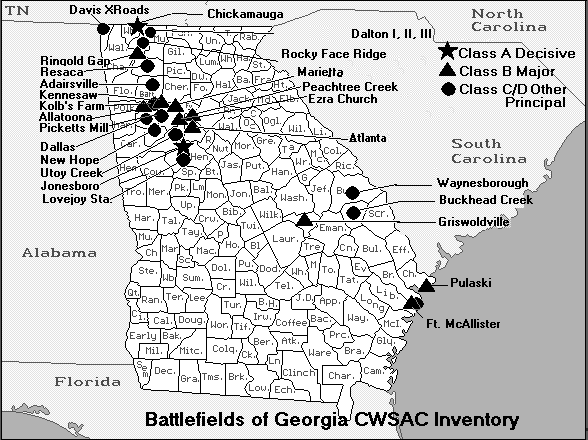

 Civil War Soldier 102 Piece Playset |
Civil War State Battle Maps American Civil War Exhibits American Civil War Timeline Civil War Summary Documents of the War Confederate President Jefferson Davis Civil War Submarines Civil War Cooking Civil War Picture Album |
 Georgia Bulldogs Sweatshirt  Civil War Soldier 102 Piece Playset
|
 The Atlanta Campaign of 1864 The operations of the Union and Confederate armies from the perspective of the soldiers and the top generals. He offers new accounts and analyses of the major events of the campaign, and, in the process, corrects many long-standing myths, misconceptions, and mistakes. He challenges the standard view of Sherman's performance. |
 Griswoldville The rise of Yankee Samuel Griswold from tineware peddler to industrial magnate. Details the history of Griswoldville from its creation to its destruction. Special attention is paid to the two military operations most closely identified with the little town: the Stoneman Raid and the stand of "Young Boys and Old Men" |
 Fields of Gray, Battle of Griswoldville, November 22, 1864 The heroic but vain fight of the Georgia troops made up of militia, state line, Athens and Augusta work battalions in their stand against Sherman's hardened veterans on their March to the Sea. In defense of family and homes the 4,000-5,000 Georgia troops under General Phillips attacked the Union right wing at Griswoldville |
Kindle Available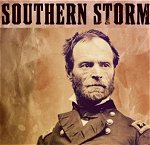 Southern Storm: Sherman's March to the Sea The destruction spanned more than sixty miles in width and virtually cut the South in two, disabling the flow of supplies to the Confederate army. He led more than 60,000 Union troops to blaze a path from Atlanta to Savannah, ordering his men to burn crops, kill livestock, and decimate everything that fed the Rebel war machine |
 Rock of Chickamauga: The Life of General George H. Thomas Union General George Thomas was one of the five men most important in the North's victory. Military historians consider him one of the best defensive generals ever, a man who would have stood out in any war |
 To Honor These Men: A History of the Phillips Georgia Legion Infantry Battalion The Georgia Legion was formed shortly after secession and fought in nearly every major engagement on the Eastern Front, including Wilderness and Appomatox |
 This Terrible Sound The Battle of Chickamauga Study of the great bloody battle of Chickamauga that was the last great offensive, although costsly, victory by the Confederates. This is a detailed account of the movements of regiments, brigades, divisions. |
 The White Tecumseh: A Biography of General William T. Sherman Utilizing regimental histories, historian Hirshon offers a sympathetic yet excellent biography of one of the more noted Civil War generals, best remembered for burning Atlanta, cutting a swath of destruction across Georgia, then creating total destruction in South Carolina, including the burning of Columbia. Hirshon gives us an insight into how Sherman's own troops felt about him and his relationships with fellow generals, especially Grant. The author not only describes Sherman's role in the war but also details his early life and family problems. The latter part of the book deals with his life after the war, especially with the Indians in the West as well as his relationships with Presidents Johnson and Grant. |
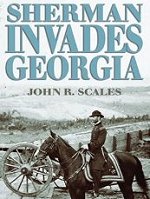 Sherman Invades Georgia: Planning the North Georgia Campaign Using a Modern Perspective Sherman Invades Georgia takes advantage of modern planning techniques to fully examine what went into the Georgia campaign. Unlike other studies, though, this one puts the reader squarely into the mind of General Sherman on the eve of his most famous military undertaking—limiting the information to that possessed by Sherman at the time, as documented in his correspondence during the campaign and not in his after-the-fact reports and autobiography. |
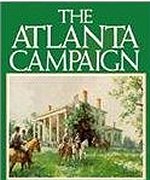 The Atlanta Campaign: A Civil War Driving Tour of Atlanta-Area Battlefields |
 The Battle of Peachtree Creek: An Audio Driving Tour This is a cd and a map packaged like an audiobook. Tour beautiful Atlanta neighborhoods while listening to audio describe the battle of Peachtree Creek. The route winds seven miles through the hills south of Buckhead before ending in Tanyard Creek Park on Collier Road. |
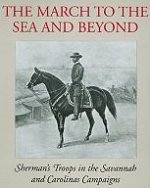 The March to the Sea and Beyond: Sherman's Troops in the Savannah and Carolinas Campaigns This book contains an examination of the army that General William Tecumseh Sherman led through Georgia and the Carolinas, in late 1864 and early 1865. Instead of being just another narrative of the March to the Sea and Carolina campaigns, however, Glatthaar's book is a look at the individuals that composed the army. In it, he examines the social and ideological backgrounds of the men in Sherman's army, and evaluates how they felt about various factors of the war--slavery, the union, and, most significantly, the campaign in which they were participating. The result is a fascinating look at Sherman's campaigns through the eyes of the everyday soldier. Amazon Reviewer |
 The Children of Pride: Selected letters of the family of the Rev. Dr. Charles Colcock Jones from the years 1860-1868 This book provides the thoughts of the entire family, all literate and well-spoken people, over the entire period from the 1850s, just living their ante-bellum experience, to the idea of the war on the horizon, entering into it and living it day by day. This is all seen through ordinary every-day experiences, family anecdotes, and discussions of what is occurring |
 Guide to the Atlanta Campaign: Rocky Face Ridge to Kennesaw Mountain Following the capture of Chattanooga, the Union initiated battles and operations that took it from the Tennessee border to the outskirts of Atlanta. Bloody confrontations at places such as Resaca and New Hope Church. Grant had ordered Sherman to penetrate the enemy's interior and inflict "all the damage you can against their War resources," |
 Savannah A large Union army led by Sherman leaves Chattanooga and northern Georgia camps and marches south to Atlanta and ultimately arrives at the coastal city of Savannah, laying waste to the territory through which it passes |
 The Battle of Resaca: Atlanta Campaign, 1864 Ideal book for a Civil War buff. Take it with you if you visit the site. Written accounts from the soldiers that stormed across the hills put you in the moment. Several good maps and even pictures taken a few days after the battle help take you out of your living room and into the past |
 |
Georgia States Rights Flag
|
| Two days after Lincoln's election, a crowd gathered on one of Savannah's public squares in a demonstration urging Georgia's secession from the Union. As documented in a lithograph of the time entitled, "The first Flag of Independence raised in the South, by the Citizens of Savannah, Ga. November 8th 1860" [detail shown above], a flag is shown hanging from the monument in the square. The flag contains a coiled snake on white background with the inscription, "Our Motto, Southern States, Equality of the States, Don't Tread on Me."
This would qualify as Georgia's earliest secession flag--and probably one of the earliest in the South. At least one secession flag of similar design survives in the collection of Georgia's Secretary of State [see above].
© Carl Vinson Institute of Government, The University of Georgia |
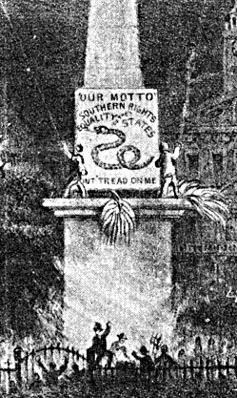 |
|
Buy this Georgia 1956-2001 Flag |
Georgia State Flag(1956-2001) In early 1955, Atlanta attorney John Sammons Bell (who later served as a judge on the Georgia Court of Appeals) suggested a new state flag for Georgia that would incorporate the Confederate Battle Flag. At the 1956 session of the General Assembly, state senators Jefferson Lee Davis and Willis Harden introduced Senate Bill 98 to change the state flag. Signed into law on February 13, 1956, the bill became effective the following July 1. A copy of the new flag displayed at the 1956 signing ceremony shows slight differences from the state flag commonly produced (and shown above). In the 1956 version, the stars are larger, and only the center point of the central star points straight up. Also, the first copies of the 1956 flag used a different version of the state seal. In the summer of 1954, a new redrawn state seal began to appear on state government documents. By the end of the decade, flag makers were using the new seal on Georgia's official state flags. |
Georgia State Flag2001-2003 The Georgia state flag adopted in 1956 has long been the subject of controversy. Calls to change it began in 1969, with opponents criticizing the symbolism expressed by the Confederate battle flag image that visually dominated the design. Throughout the 1980s and 1990s, numerous bills to return to the pre-1956 flag were introduced in the General Assembly -- but none were successful. In 2000, Atlanta architect Cecil Alexander designed a new state flag consisting of the seal of the state in "Dahlonega gold" surrounded by 13 white stars above a gold ribbon containing small images of the three state flags that had flown over Georgia, as well as the first and current versions of the U.S. national flag. Above the five small flags was the phrase "Georgia's History." On Jan. 24, 2001, the Georgia House approved H.B. 16, adopting Alexander's flag design as the new Georgia state flag with an amendment to add "In God We Trust" beneath the ribbon of flags. H.B. 16 was transmitted to the Senate, where it passed without amendment on Jan. 30, 2001. On Jan. 31, Gov. Roy Barnes signed the bill into law. |
Buy this current Georgia State Flag |
Current Georgia State FlagOn May 8, 2003, Governor Sonny Perdue signed H.B. 380 creating a new state flag for Georgia. The act became effective immediately, giving Georgia its third state flag in a period of 27 months. Support for the new flag came from critics of the 2001 flag and those who felt there should be a public referendum on the state flag. The legislation also provided for a statewide advisory referendum on March 2, 2004, at which time voters will choose between the 2001 and 2003 flags. However, results of the referendum are not binding, and any future flag change will require an act of the General Assembly Georgia's new state flag is based on the first national flag of the Confederacy (the "Stars and Bars") and consists of a field of three horizontal bars of equal width, two red separated by a white bar in the center. In the upper left corner is a square blue canton the width of two bars. In the center of the canton is a circle of 13 white stars, symbolizing Georgia and the other 12 original states that formed the United States of America. Within the circle of stars is Georgia's coat of arms (the central design on the state seal) immediately above the words "In God We Trust" -- both in gold. |
Bonnie Blue Flag Bonnie Blue The Confederate government did not adopt this flag but the people did and the lone star flags were adopted in some form in five of the southern States that adopted new flags in 1861. |
Southern Cross Flag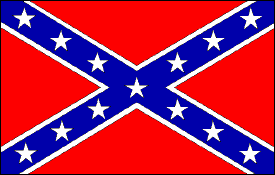 Used as a navy jack at sea from 1863 onward. This flag has become the generally recognized symbol of the South. |
Second Confederate Flag  On May 1st,1863, a second design was adopted, placing the Battle Flag (also known as the "Southern Cross") as the canton on a white field. This flag was easily mistaken for a white flag of surrender especially when the air was calm and the flag hung limply. More on Confederate Flags |
 Sherman's Horsemen by: David Evans Union Cavalry Operations in the Atlanta Campaign |
A comprehensive study of the role of the cavalry in Sherman's coordinated assault on Atlanta in 1864, involving three federal armies that swept in from the west through Alabama and Georgia
A vivid account of the campaign that helped decide the outcome of the Civil War. Evans provides a comprehensive study of the role of the cavalry in Sherman's coordinated assault on Atlanta in 1864, involving three federal armies that swept in from the west through Alabama and Georgia. Those armies left a horrible wake of damage in their path, and they suffered horribly as well. Evans writes of their work with a keen eye for detail, describing the confusion of the battlefield and the bloody aftermath of a cavalry engagement. |
Kindle Available Benning's Brigade by Dave Dameron |
A History and Roster of the Fifteenth Georgia, takes the reader on an exciting, fact-filled chronicle through the Civil War as experienced by the men from Georgia. The narrative is filled with excerpts from numerous primary sources. Detailed end-notes complement and clarify the book's references. The roster is extracted directly from the National Archives(CSA)records. The roster was placed in an electronic data base from which statistics were compiled and charts created. Original battle maps highlight regimental and brigade locations at key battles. Rare photographs of soldiers, hand written journal entries,weapons, and their beloved unit flag provide the reader with graphic treasures of the past. Also, classic and relevant civil war engravings, present a vivid, eyewitness account of key events experienced by the unit. These encompassing perspectives of the "Fighting Fifteenth" and the "Rock Brigade," provide the serious researcher or history buff an insightful and entertaining survey of an important aspect of our American heritage. |